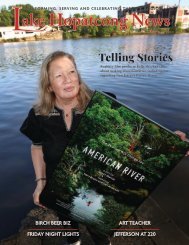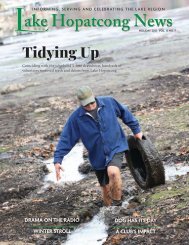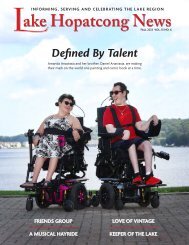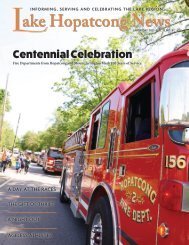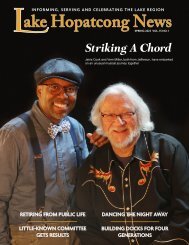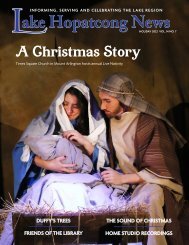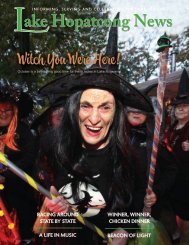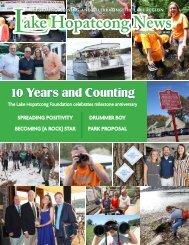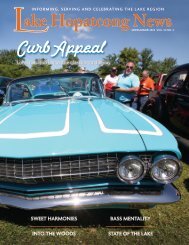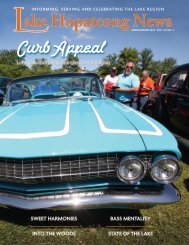You also want an ePaper? Increase the reach of your titles
YUMPU automatically turns print PDFs into web optimized ePapers that Google loves.
New Program Offers Peace of Mind for Families<br />
Story by MICHAEL DAIGLE<br />
Photos by Karen Fucito<br />
The badge offers a simple plea: “If I appear<br />
lost, please call.”<br />
The badge lists a telephone number and an<br />
identification number.<br />
Simple.<br />
But the simplicity more than likely masks<br />
a complex circumstance that could involve<br />
a child, an aging adult, or illness, disability or<br />
both.<br />
Quietly, the badge suggests concern and<br />
calls for immediate action.<br />
The badge is the brainchild of Paul Jetter of<br />
Fredon, who founded a nonprofit organization<br />
called Safely Back Home to create a way to<br />
help seniors with dementia or children with<br />
autism, for example, get back home if they<br />
have wandered away accidently or on purpose.<br />
Either case, Jetter said, could cause a<br />
confusing situation for the wanderer and<br />
potential helper, circumstances made worse,<br />
for example, if the person wearing the badge<br />
on their clothes is nonverbal, disoriented or<br />
language-limited.<br />
“One goal of the badge is to de-escalate the<br />
situation,” he said.<br />
Hopatcong Borough was the first Sussex<br />
County municipality to join Jetter’s Safely Back<br />
Home program in March. Hopatcong schools<br />
joined in May. The program is being funded<br />
through the borough, said Jetter, and will be<br />
available to other municipalities in the near<br />
future.<br />
Jetter said the idea was formulated when his<br />
father, then 85, showed signs of dementia.<br />
“It was a family response with my brother<br />
becoming primary caregiver. It was a full-time<br />
responsibility,” Jetter said.<br />
But his father wandered, as do six of 10<br />
dementia patients, he said. The fear was that<br />
his father would not recognize where he was<br />
or be able to explain how to get back home.<br />
In 2010, after his father died, Jetter<br />
connected with Project Lifesaver, a national<br />
organization with links to law enforcement<br />
offices nationwide and other groups that aim<br />
to protect people who wander from safe<br />
environments, such as a home or health facility.<br />
Project Lifesaver offers GPS monitors and<br />
bracelets as a means of providing identification<br />
and location. Jetter said he wanted to add<br />
an ID method that could not be removed<br />
by the wearer, was easy to apply and was<br />
made of a material that would not irritate an<br />
autistic person for whom changes in texture<br />
can trigger negative responses. Jetter said he<br />
experimented with fabrics and adhesives for<br />
years.<br />
During the process to develop his idea,<br />
Jetter said he reached out to New Jersey State<br />
Association of Chiefs of Police and developed<br />
interest from 70 police chiefs. Six towns in<br />
Bergen County joined the program in 2016, he<br />
said. Not yet a nonprofit and with no outside<br />
funding, Jetter said he incurred the cost of the<br />
badges himself, something he knew would be<br />
unsustainable. Within two years, these first<br />
programs were dormant, he said.<br />
But Jetter didn’t give up. In 2020, he secured<br />
nonprofit status for Safely Back Home, which<br />
led to a $3,000 grant from the Starbucks<br />
Foundation, courtesy of the employees from<br />
the Sparta Starbucks. The money helped<br />
kickstart the program again, which offers<br />
training for dispatchers and police officers who<br />
either receive an emergency call from a person<br />
who sees a badge or respond to a location<br />
where a person who has wandered was found.<br />
Hopatcong Borough Councilwoman<br />
Christine Smith found out about the program<br />
through a friend, said Jetter. She, Councilman<br />
Brad Hoferkamp and Mayor Michael Francis<br />
championed the program.<br />
Smith said the program hits home because<br />
her father had Alzheimer’s and wandered. The<br />
condition was made worse when he moved<br />
to New Jersey from New Hampshire and the<br />
landscape changed.<br />
She also has an adopted daughter who is<br />
nonverbal, which makes this program a critical<br />
addition to keeping her safe.<br />
“This is a tool for communication in a critical<br />
situation if needed,” Smith said.<br />
She was eager to have Jetter speak with the<br />
borough’s seniors, which he did at one of the<br />
group’s weekly meetings. The<br />
U.S. Census said that in 2022,<br />
13.9 percent of Hopatcong’s<br />
14,531 residents were 65 or older, or 1,941<br />
persons.<br />
Enrollment forms are also available at the<br />
Hopatcong Wellness Center on Hopatchung<br />
Road and on the Safely Back Home website.<br />
Jetter said by June, a dozen Hopatcong families<br />
has signed up for the program.<br />
Tammy Miller, the director of student<br />
special services for Hopatcong schools, said six<br />
families enrolled in May.<br />
The families each brought in about 20 pieces<br />
of clothing so that the soft, cloth badges<br />
could be added. Families will need to bring in<br />
different clothing as the children age and grow,<br />
she said.<br />
Working out of his garage, Jetter uses a heat<br />
press to secure the badges to clothing and hats<br />
but said anyone can use a hot iron to get the<br />
same results.<br />
Miller said other programs use dog tags<br />
or other styles of identification, which can<br />
become lost, or among certain children,<br />
become bothersome.<br />
“The badge is a secure form of identification,”<br />
she said. “This is appropriate if they flee or get<br />
lost.”<br />
With a reduced ability to speak or socialize,<br />
Miller said, the student could become<br />
disoriented or agitated if lost, unable to tell<br />
a potential rescuer their name or other basic<br />
information. Sometimes such students act out<br />
or scream, she said.<br />
She agreed with Jetter that the badges can<br />
act as a tool to de-escalate what might be a<br />
tense or confusing situation. They can offer<br />
education to the general public.<br />
In mid-June, Jetter delivered back to the<br />
Hopatcong families their garments individually<br />
imprinted with the Safely Back Home badges.<br />
Joanna Tiritilli enrolled her 9-year-old<br />
daughter Lena in the Safely Back Home<br />
program as another level of protection. The<br />
badge augments information on Lena’s medical<br />
alert bracelet, she said.<br />
Lena is nonverbal and has epilepsy. She also<br />
loves swimming, her mother said.<br />
“We have to be super careful,” Tiritilli said.<br />
“It’s a challenge.<br />
She does not have<br />
a bit of fear.”<br />
Taking her<br />
out in public<br />
can be stressful,<br />
20<br />
LAKE HOPATCONG NEWS <strong>Midsummer</strong> <strong>2023</strong><br />
Left to right: Paul<br />
Jetter presents his<br />
Safely Back Home<br />
program to seniors<br />
in Hopatcong.<br />
Xavier Subero with<br />
his mom, Ashley<br />
Labar.



